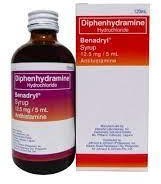A nurse is planning to administer diphenhydramine 1.25 mg/kg IV to a school-age child who weighs 55 lb. Available is diphenhydramine 50 mg/mL. How many ml should the nurse administer?
(Round the answer to the nearest tenth. Use a leading zero if it applies. Do not use a trailing zero.)
The Correct Answer is ["0.6"]
Rationale:
First, we need to convert the child's weight from pounds to kilograms. We can do this by dividing 55 by 2.2, which gives us 25 kg.
Next, we need to multiply the dose of diphenhydramine by the child's weight to get the total amount of medication needed. We can do this by multiplying 1.25 mg/kg by 25 kg, which gives us 31.25 mg.
Finally, we need to divide the total amount of medication by the concentration of the solution to get the volume to be administered. We can do this by dividing 31.25 mg by 50 mg/mL, which gives us 0.625 mL.
To round the answer to the nearest tenth, we look at the hundredths place and see that it is 5 or more, so we round up the tenths place by one. Therefore, the nurse should administer 0.6 mL of diphenhydramine IV to the child.
 |
Nursing Test Bank
Naxlex Comprehensive Predictor Exams
Related Questions
Correct Answer is ["A","B"]
Explanation
Rationale:
A. The MMR vaccine is typically administered at 12 months of age as part of routine immunization schedules.
B. The varicella vaccine is typically administered at 12 months of age as part of routine immunization schedules.
C. Rotavirus (RV): The rotavirus vaccine is typically administered at 2, 4, and 6 months of age.
D. The herpes zoster vaccine is not routinely administered to infants at 12 months of age.
E. The HPV vaccine is typically administered starting at age 11 or 12 years, not at 12 months of age.
Correct Answer is A
Explanation
Rationale:
A. A toddler who has a heart rate of 68/min is likely to have bradycardia, a slow heart rate that can affect oxygen delivery. Bradycardia could be caused by hypoxia, hypothermia, or cardiac problems. The nurse should report this finding to the provider immediately.
B. This temperature is within the normal range, so it does not require reporting.
C. This blood pressure is within the normal range for an adolescent, so it does not require reporting.
D. The normal respiratory rate for a 3-month-old infant is 25 to 40/min.
Whether you are a student looking to ace your exams or a practicing nurse seeking to enhance your expertise , our nursing education contents will empower you with the confidence and competence to make a difference in the lives of patients and become a respected leader in the healthcare field.
Visit Naxlex, invest in your future and unlock endless possibilities with our unparalleled nursing education contents today
Report Wrong Answer on the Current Question
Do you disagree with the answer? If yes, what is your expected answer? Explain.
Kindly be descriptive with the issue you are facing.
